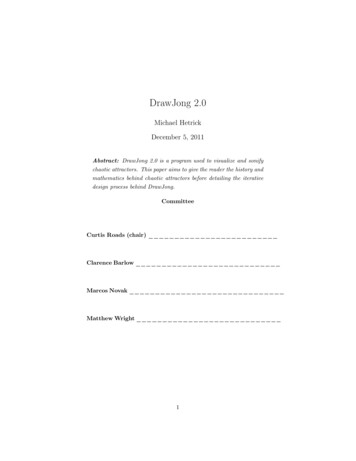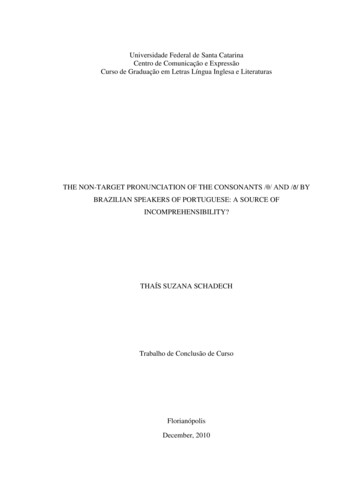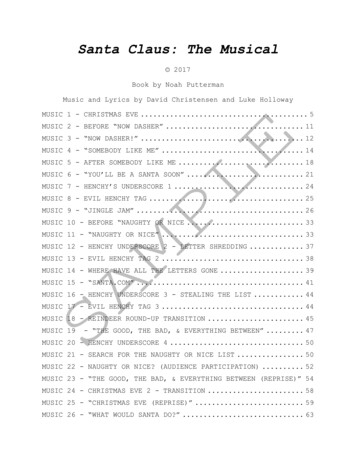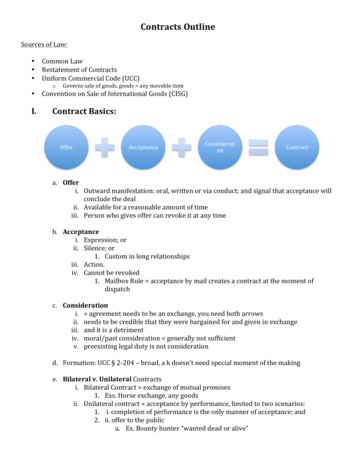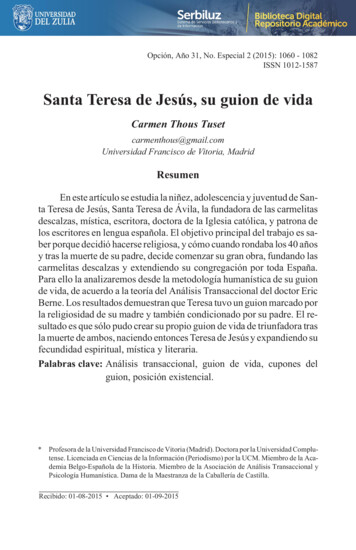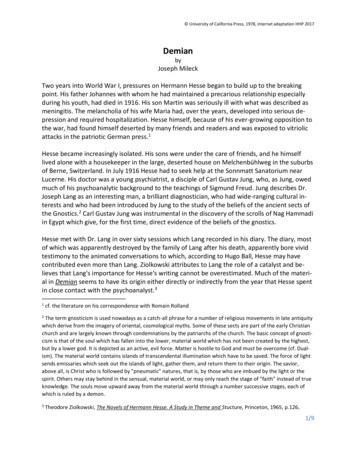
Transcription
University of California Press, 1978, internet adaptation HHP 2017DemianbyJoseph MileckTwo years into World War I, pressures on Hermann Hesse began to build up to the breakingpoint. His father Johannes with whom he had maintained a precarious relationship especiallyduring his youth, had died in 1916. His son Martin was seriously ill with what was described asmeningitis. The melancholia of his wife Maria had, over the years, developed into serious depression and required hospitalization. Hesse himself, because of his ever-growing opposition tothe war, had found himself deserted by many friends and readers and was exposed to vitriolicattacks in the patriotic German press.1Hesse became increasingly isolated. His sons were under the care of friends, and he himselflived alone with a housekeeper in the large, deserted house on Melchenbühlweg in the suburbsof Berne, Switzerland. In July 1916 Hesse had to seek help at the Sonnmatt Sanatorium nearLucerne. His doctor was a young psychiatrist, a disciple of Carl Gustav Jung, who, as Jung, owedmuch of his psychoanalytic background to the teachings of Sigmund Freud. Jung describes Dr.Joseph Lang as an interesting man, a brilliant diagnostician, who had wide-ranging cultural interests and who had been introduced by Jung to the study of the beliefs of the ancient sects ofthe Gnostics.2 Carl Gustav Jung was instrumental in the discovery of the scrolls of Nag Hammadiin Egypt which give, for the first time, direct evidence of the beliefs of the gnostics.Hesse met with Dr. Lang in over sixty sessions which Lang recorded in his diary. The diary, mostof which was apparently destroyed by the family of Lang after his death, apparently bore vividtestimony to the animated conversations to which, according to Hugo Ball, Hesse may havecontributed even more than Lang. Ziolkowski attributes to Lang the role of a catalyst and believes that Lang's importance for Hesse's writing cannot be overestimated. Much of the material in Demian seems to have its origin either directly or indirectly from the year that Hesse spentin close contact with the psychoanalyst.31cf. the literature on his correspondence with Romain Rolland2The term gnosticism is used nowadays as a catch-all phrase for a number of religious movements in late antiquitywhich derive from the imagery of oriental, cosmological myths. Some of these sects are part of the early Christianchurch and are largely known through condemnations by the patriarchs of the church. The basic concept of gnosticism is that of the soul which has fallen into the lower, material world which has not been created by the highest,but by a lower god. It is depicted as an active, evil force. Matter is hostile to God and must be overcome (cf. Dualism). The material world contains islands of transcendental illumination which have to be saved. The force of lightsends emissaries which seek out the islands of light, gather them, and return them to their origin. The savior,above all, is Christ who is followed by "pneumatic" natures, that is, by those who are imbued by the light or thespirit. Others may stay behind in the sensual, material world, or may only reach the stage of "faith" instead of trueknowledge. The souls move upward away from the material world through a number successive stages, each ofwhich is ruled by a demon.3Theodore Ziolkowski, The Novels of Hermann Hesse. A Study in Theme and Stucture, Princeton, 1965, p.126.1/9
University of California Press, 1978, internet adaptation HHP 2017The encounter with psychoanalysis proved to be "an encounter with real powers".4 In November 1916 Hesse was released from the sanatorium as being totally recovered. He had undergone what he felt to be his rebirth as a new man and artist. He continued to maintain close tieswith Dr. Joseph Lang for the rest of his life. Lang appeared as a figure in Demian and also inHesse's later prose and poetry in transparent disguise.Hesse had been advised by his analyst to renew his interest in drawing and painting and soonbegan to roam through the countryside with easel and watercolors. He also began to writeDemian in 1917, a book in which he recorded the process of his own rebirth. In Demian we findmuch material from analytical psychology. Although it presents faithfully the various stages ofself-discovery, Hesse later emphasized that as an artist he had taken an independent, creativeapproach to what Jung himself came to consider a sample case history of the process of psychological therapy. As a piece of literature, the book was based on intuition rather than analysis.He felt that Freud and Jung only confirmed the poet's intuitive understanding of the subconscious.5 Even although Jung himself later expressed his conviction, that much of Hesse's workbeginning with Demian was based on insights which he himself directly or indirectly through Dr.Lang had communicated to Hesse, whether Hesse was aware of it or not, one is tempted topoint out the continuity of themes which make Demian only the part of a chain beginning withHesse's earliest publications. At the time when Hesse wrote about Hans Giebenrath in Beneaththe Wheel, he had had very little opportunity to read either Freud or Jung. Hesse believed thatthe artist must relentlessly pursue the inward way, he must establish his identity, he cannot utilize the easy solution of conformity, his fate is loneliness. Like the analyst, the poet must "listento the hidden sources" and he must face up to himself.In 1919 Demian: The Story of Emil Sinclair’s Youth appeared under the pseudonym Emil Sinclair.Hesse had chosen to write under a pseudonym for a variety of reasons. First of all, the name ofEmil Sinclair which was based on Hölderlin's friend Isaac von Sinclair, expressed his desire tobreak with his own past. In periods of depression Hesse had taken a dim view of his own writings and professed to have abandoned the search for recognition as an author and poet. In1922 he wrote:My attempt to have my person disappear behind my work has been publicized and foiled byjournalists in the case of Demian despite my most serious efforts.64VII, 143.5cf. "Artists and Psychoanalysis". My Belief, New York: Farrar, Strauss and Giroux, 1974, pp.46-51.6Letter to Hans Reinhart, February 1922. Hermann Hesse: Gesammelte Briefe, II, Frankfurt: Suhrkamp, 1979,p.11.22/9
University of California Press, 1978, internet adaptation HHP 2017Secondly, since Hesse had maintained his reputation as a pre-war author and had receivedmuch negative feedback because of his opposition to the war, the pseudonym seemed to guarantee him a degree of privacy.7 On January 3, 1917 Hesse wrote to his friend, the painter HansSturzenegger:Ich z.B. bin mir seit langem darüber klar, daß meine Stellungnahme (auch meiner amtlichenTätigkeit) mich eines Tages zum Bruch mit Heimat, Stellung, Familie, Namen etc. führen kann,und ich bin entschlossen, es darauf ankommen zu lassen.8Last not least, Hesse sought to avoid alienating a new generation of potential readers whomight have felt that he, a member of the older generation, had nothing to contribute toward aresolution of their post-war plight. The book, sure enough, was written in a new style, it contained new views, and its Weltanschauung had unalterably changed from that of the pre-waryears.The book's title was ambiguous. The name "Demian" was obviously based on the Greek worddaimon, (God, divine being, devil, fate), yet the book was the story of Emil Sinclair, and Demianappeared only as a "supporting character". One had to assume that Demian was to be seen notliterally as a discrete character, but as a force or an aspect of Emil Sinclair himself. The byline ofthe title spoke of "The History of an Adolescence”.9 Remembering that Hesse's writings tendedto be highly autobiographical, the adolescence he was referring to must have resembled hisown. Yet Hesse, at the writing of Demian had turned forty. The book itself and the experiencesof its characters were affected significantly by the war. Hesse, in his own youth, had given noindication whatever of anticipating the political events that would lead to the war, nor had heactually participated in the war. As a matter of fact, his preoccupation with his own personaldevelopment and his psychological orientation and his outsiderdom, effectively precluded social and political involvement at a grand scale. One should therefore interpret the subtitle tomean that Hesse did not consider the process of growing-up as being limited to one's earlyyears, nor did he make the first-hand experience of modern war a prerequisite for the experience of crisis and chaos. His own experience during the wartime crisis, including his analysis,proved only that the process of maturation continued throughout one's lifetime. Most of thereaders of Demian were young people, many of them returning from the war. They felt theyrecognized in the author of Demian one of their own. The story of one youth had become thestory of many youths, as a matter of fact of an entire generation, and the German subtitle ofthe book was appropriately nonspecific. Hesse, under the pseudonym of Emil Sinclair, had ac7Hesse was urged in 1917 to desist from publishing his controversial political essays in order not to endanger hiswork for the prisoners-of-war. Between 1914 and 1919 he published about twenty-five political essays, some ofthem under the pseudonym Emil Sinclair. cf. Siegfried Unseld, Hermann Hesse: Eine Werkgeschichte, Frankfurt:Suhrkamp. 1973.8“Hermann Hesse. Briefe“, Neue Rundschau, 83, 2 (1972), 214.9“Die Geschichte einer Jugend”, translated by Michael Roloff as “The Story of Emil Sinclair’s Youth”, Bantam, 1965.3/9
University of California Press, 1978, internet adaptation HHP 2017complished a remarkable feat: across the generations he had managed to be accepted as aspokesman of a multitude of young people. In his later works, Hesse was to repeat this accomplishment a number of times. Most remarkable was his acceptance by young Americans duringthe Vietnam era. Particularly this latter phenomenon could be seen as further proof that Hessedid not consciously cater to the tastes of the time.Demian had, in the words of Thomas Mann, a great "electrifying" effect. It won the FontanePrize for the best novel of a young unknown author. Although Hesse's publisher Samuel Fischersaw no reason to doubt Hermann Hesse who had transmitted the manuscript to him presumably for a young unknown friend, a number of Hesse's friends and acquaintances were quick torecognize him as the author. Among them was Carl Gustav Jung. In January 1920 Hesse exhorted his doctor and friend Josef Bernhard Lang not to reveal his authorship although there weresigns that people were about to guess who the real author was.10 After Eduard Korrodi hadpublished two essays on the authorship of Demian in a major Swiss newspaper,11 and had askedHesse to lift the pseudonym, Hesse returned the Fontane-Prize. The 17th edition of Demian appeared under Hesse's own name. In 1934 Hesse wrote in a letter that Korrodi originally hadpraised the anonymous Demian, without guessing its author, and in part at the expense ofHermann Hesse, only to be embarrassed and resentful later when he discovered his mistake.The book began with a prologue, as was Hesse's practice. The prologue provided the tone andset the frame for the work. If Hesse had not selected the pseudonym of Emil Sinclair, he probably would have stated in the introduction that some friend or archivist was sifting through theleft papers of Emil Sinclair and had the following to report. Hesse in real life had preemptedthat type of distancing by forwarding his own manuscript to Samuel Fischer presumably for hisunknown friend, Sinclair.The prologue of two pages is in many ways an outstanding concise statement of Hesse's Weltanschauung. First, he emphasizes that the story is his own, which is true and not true at thesame time. He also rejects the omniscient role of the novelists who "tend to take an almostgodlike attitude toward their subject, pretending to a total comprehension of the story, a man'slife, which they can therefore recount as God Himself might, nothing standing between themand the naked truth, the entire story meaningful in every detail."12Hesse then stresses that the story deals with a real, not an imaginary person, and that this person is unique, since every human being "represents a unique and valuable experiment on the10Montagnola, January 26, 1920. Hermann Hesse: Gesammelte Briefe, I, Frankfurt: Suhrkamp, 1978. 442f.Eduard Korrodi, "Wer ist der Dichter des Demian?", Neue Zürcher Zeitung, Nr.1050, June 24, 1920; "An HermannHesse, den Dichter des Demian", ibid., Nr.1112, July 5, 1920.1111Translated from the German by Michael Roloff and Michael Lebeck, Bantam, 1965.12Translated from the German by Michael Roloff and Michael Lebeck, Bantam, 1965.4/9
University of California Press, 1978, internet adaptation HHP 2017part of nature." The novelist's13 purpose is to stress the uniqueness of man, which is a significant and urgent task considering that in the present age human beings have come to be regarded as canon-fodder and are "shot wholesale". The individual is "the very special and alwayssignificant and remarkable point at which the world's phenomena intersect, only once in thisway and never again." Thus, each human being is wondrous, worthy of respect and every consideration. "Within each one a redeemer is nailed to the cross."The author does not intend to lecture his readers with his supreme insights. He himself is stilllooking for the answers, but he has learned not to look for them in "stars and books". 14 Eachindividual will have to find his own answers within himself. If that inward search reveals muchthat is utterly disturbing and unsettling, one should not be discouraged. The goal is to becomeutterly and completely oneself. Some approach this goal intelligently, others awkwardly to thebest of their ability. They try
18.09.2017 · Demian in 1917, a book in which he recorded the process of his own rebirth. In Demian we find much material from analytical psychology. Although it presents faithfully the various stages of self-discovery, Hesse later emphasized that as an artist he had taken an independent, creative approach to what Jung himself came to consider a sample case history of the process of psycho- logical therapy .File Size: 547KBPage Count: 9



